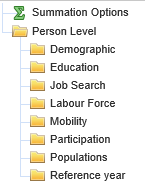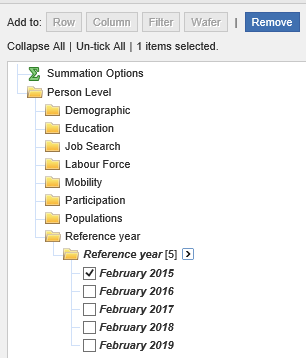FILE STRUCTURE AND CONTENT
FILE STRUCTURE
The underlying format of the Participation, Job Search and Mobility (PJSM) TableBuilder file is structured at a single person level. This person level contains general demographic information such as age, sex and country of birth as well details about underemployed workers, persons not in the labour force, unemployed persons and educational qualifications.
When tabulating data from TableBuilder, person weights are automatically applied to the underlying sample counts to provide the survey's population estimates.
The data items included in the PJSM TableBuilder are grouped under broad headings and subheadings as shown in the image below. A complete data items list can be accessed from the Downloads tab.

FILE STRUCTURE
Reference Year
From 2017, the PJSM TableBuilder contains a mandatory field called Reference year to allow for historical analysis. By default this field will be present in any new table as per the image below:

Individual years can be removed from the table using the data item panel by selecting the required year and removing it from the table as per the image below:

However, at least one category (reference year) of the mandatory field must be present in a table for TableBuilder to retrieve data.
Not Applicable Categories
Most data items included in the TableBuilder file include a 'Not applicable' category. The classification values of these 'Not applicable' categories, where relevant, are shown in the data item list in the Downloads tab. The 'Not applicable' category generally represents the number of people who were not asked a particular question or the number of people excluded from the population for a data item when that data were derived (e.g. Hours usually worked in main job is not applicable for unemployed persons or persons not in the labour force).
Table Populations
The population relevant to each data item is identified in the data item list and should be kept in mind when extracting and analysing data. The actual population count for each data item is equal to the total cumulative frequency minus the 'Not applicable' category.
Generally, some populations can be 'filtered' using other relevant data items. For example, if the population of interest is 'Employed', any data item with that population (excluding the 'Not applicable' category) could be used.
Zero Value Cells
Tables generated from sample surveys will sometimes contain cells with zero values because no respondents that satisfied the parameters of a particular cell in a table were in the survey. This is despite there being people in the general population with those characteristics. This is an example of sampling variability which occurs with all sample surveys. Relative Standard Errors cannot be generated for zero cells.
 Print Page
Print Page
 Print All
Print All
 Quality Declaration
Quality Declaration